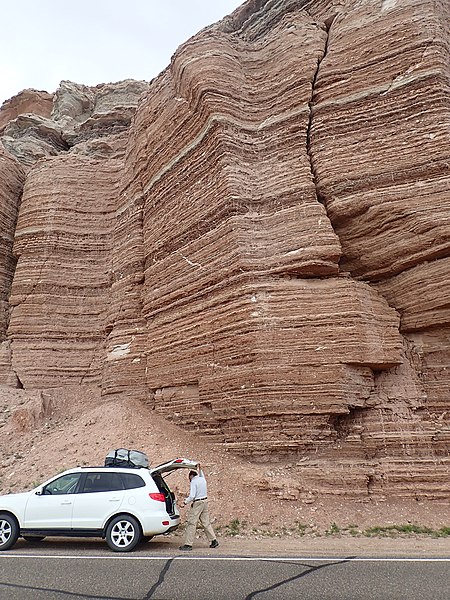The Chinle Formation is an Upper Triassic continental geological formation of fluvial, lacustrine, and palustrine to eolian deposits spread across the U.S. states of Nevada, Utah, northern Arizona, western New Mexico, and western Colorado. In New Mexico, it is often raised to the status of a geological group, the Chinle Group. Some authors have controversially considered the Chinle to be synonymous to the Dockum Group of eastern Colorado and New Mexico, western Texas, the Oklahoma panhandle, and southwestern Kansas. The Chinle Formation is part of the Colorado Plateau, Basin and Range, and the southern section of the Interior Plains. A probable separate depositional basin within the Chinle is found in northwestern Colorado and northeastern Utah. The southern portion of the Chinle reaches a maximum thickness of a little over 520 meters (1,710 ft). Typically, the Chinle rests unconformably on the Moenkopi Formation.
Chinle Badlands, Grand Staircase–Escalante National Monument, Utah, US.
Fossil wood from Chinle Formation exposures at Petrified Forest National Park
Petrified Forest National Park araucarioxylon fossil wood weathered from the Chinle Formation
The Whitaker ("Coelophysis") Quarry at Ghost Ranch, preserving the "siltstone member" of the Chinle Formation
A geological formation, or simply formation, is a body of rock having a consistent set of physical characteristics (lithology) that distinguishes it from adjacent bodies of rock, and which occupies a particular position in the layers of rock exposed in a geographical region. It is the fundamental unit of lithostratigraphy, the study of strata or rock layers.
A geologic cross section of the Grand Canyon. Black numbers correspond to groups of formations and white numbers correspond to formations (click on picture for more information)
The Permian through Jurassic strata of the Colorado Plateau area of southeastern Utah demonstrate the principles of stratigraphy. These strata make up much of the famous prominent rock formations in widely spaced protected areas such as Capitol Reef National Park and Canyonlands National Park. From top to bottom: Rounded tan domes of the Navajo Sandstone, layered red Kayenta Formation, cliff-forming, vertically jointed, red Wingate Sandstone, slope-forming, purplish
Uluru (Ayers Rock) in Australia is underlain by the Mutitjulu Arkose, a formation composed almost entirely of a single lithology (arkosic sandstone).
The Summerville Formation is composed of alternating thin beds of two lithologies, mudstone and sandstone, penetrated by veins of a third lithology, gypsum.








